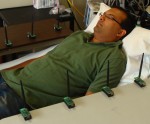Researchers use wireless network to monitor breathing, could save lives

When Neal Patwari and his team of researchers developed a wireless network capable of seeing through walls , we assumed they were simply looking to cultivate their Alastor Moody-like superpowers. Turns out, they had far more important things on their minds. Patwari and his colleagues at the University of Utah have now penned a new study in which they demonstrate how their motion detecting technology could be used to monitor breathing patterns, as well, potentially enabling doctors to keep closer track of patients with sleep apnea or babies susceptible to sudden infant death syndrome (SIDS). To do this, Patwari reclined on a hospital bed and surrounded himself with 20 wireless transceivers operating at a frequency of 2.4GHz, as pictured above. He then timed his breathing at about 15 breaths per minute (the average rate for a resting adult), which he measured with his array of nodes and a carbon dioxide monitor. The engineer ultimately found that his system’s algorithm could accurately measure respiration within 0.4 to 0.2 breaths per minute — a relatively low error rate, since most monitors round off to the nearest full breath. Patwari says this development could offer a non-invasive and low-cost alternative to the devices used in most hospitals, and hopes to implement his technology into at-home baby monitors, as well. He acknowledges, however, that it will likely take at least five years before any of that happens — so don’t hold your breath. Full PR after the break. Continue reading Researchers use wireless network to monitor breathing, could save lives Researchers use wireless network to monitor breathing, could save lives originally appeared on Engadget on Mon, 19 Sep 2011 07:16:00 EDT. Please see our terms for use of feeds . Permalink